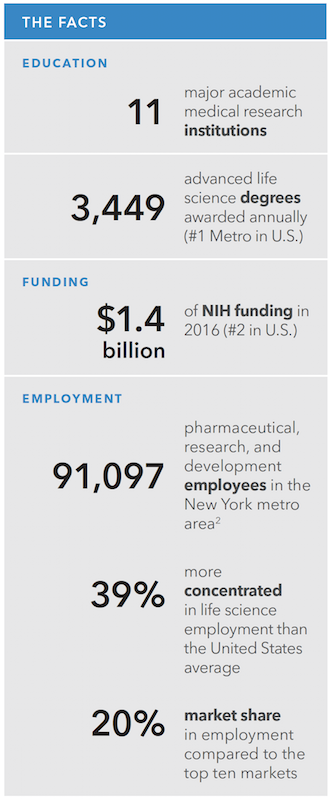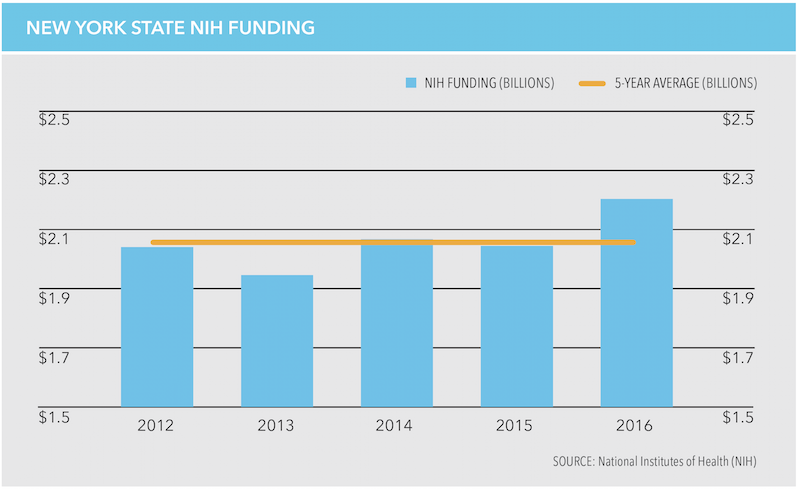Developers Taconic Investment Partners and Silverstein Properties are spending $20 million to renovate the 326,861-sf Movie Lab building in Midtown Manhattan for life science research usage.
The New York Post reports that the Stem Cell Foundation has leased 42,100 sf in this building since 2015. Another 150,000 sf on the top floors of this 10-story building are being upgraded to attract more life science tenants. The building reportedly is changing its name to the Hudson Research Center.
Transwestern, which is marketing this lab space for the developers, has released a special report that portrays New York City as an emerging life sciences hub, where space is tight and development opportunities are multiplying.
New York is already a significant player in this field, by virtue of being home to 11 major academic medical centers, including Weill Cornell Medical College and Albert Einstein College of Medicine. The city also has three of the country’s top 15 hospitals and five of the top 50 medical schools, according to U.S. News and World Report’s latest report card.

New York City is already a leader in life sciences employment and, more recently, available funding. Image: Transwestern
The city also one of the country’s highest concentrations of life-science employees, accounting for one-fifth of the total employment in this sector within the top 10 life science markets.
The problem is shortage of lab space. Transwestern estimates that 100% of the city’s 1.7 million sf of existing life science and research space is occupied. And until recently, New York’s zoning restrictions made it particularly tough for life science companies to build lab space within manufacturing districts—M Zones—that restrict chemical compounding and packaging, the creation of pharmaceutical products and medical appliances, laboratories, research, experimental and testing facilities.
But over the past year or so, market and regulatory changes have made development more conducive for lab science expansion.
Indeed, recent lease transactions have included 49,143 sf at 10 Hudson Yards for Intercept Pharmaceuticals, 30,000 sf at 101 Avenue of the Americas for JLABS (division of J&J Innovations), 19,645 sf at 100 Wall Street for Integra Partners, 11,865 sf at 600 Third Avenue for Turing Pharmaceuticals, and 11,537 sf at 25 West 45th Street for Crossover Health.
More investment capital and funding are flowing into the city for this sector. Out of the $31.3 billion in National Institutes of Health funding awarded nationally in 2016, the New York metro area received $2.7 billion in NIH grants. New York City alone was awarded $1.4 billion, ranking it the second-highest funded city in the country.

More dollars from the National Institutes of Health are flowing into New York State and, particularly, New York City. Image: NIH/Transwestern
Last December, New York Governor Andrew Cuomo unveiled a state-funded life science initiative that includes $250 million in tax incentives for new and existing life science companies, $200 million in state capital grants to further support investment in wet-lab and innovation space, $100 million in investment capital for early stage life science initiatives, and a state match of at least $100 million for operating support from private sector partnerships.
New York City Mayor Bill DiBlasio also has launched a program called LifeSci NYC, which will include a $100 million investment to create a new applied life science campus, $50 million to expand a network of life science R&D facilities, $10 million to expand the network of incubators, $20 million a year in matching funds to support early-stage businesses, and $300 million in tax incentives for commercial lab space.
On the zoning front, in December the Departments of Buildings (DOB) and City Planning (DCP), and the Economic Development Corporation (EDC) issued a clarification memo updating their interpretation of the zoning in the several commercial districts.
The city agencies and the EDC, says Transwestern, “broadened their understanding of the current use group 9A zoning to also include the “synthesis and manipulation of chemical substances, biological matter, and animal models … [that] are integral activities in commercial medical laboratories devoted to research and testing.”
Already, new research and lab spaces are popping up. The Cornell Tech campus on New York City’s Roosevelt Island just opened its first phase. And the 1.17-million-sf Building 77 at the Brooklyn Navy Yard is undergoing a $185 million renovation that could attract lab tenants.
Related Stories
K-12 Schools | May 12, 2023
In Virginia, a new high school building helps reimagine the experience for 1,600 students
In Virginia, the City of Alexandria recently celebrated the topping out of a new building for Alexandria City High School. When complete in 2025, the high-performance structure will accommodate 1,600 students.
University Buildings | May 11, 2023
New ‘bold and twisting’ building consolidates School of Continuing Studies at York University
The design of a new building that consolidates York University’s School of Continuing Studies into one location is a new architectural landmark at the Toronto school’s Keele Campus. “The design is emblematic of the school’s identity and culture, which is centered around accelerated professional growth in the face of a continuously evolving labor market,” according to a news release from Perkins&Will.
University Buildings | May 5, 2023
New health sciences center at St. John’s University will feature geothermal heating, cooling
The recently topped off St. Vincent Health Sciences Center at St. John’s University in New York City will feature impressive green features including geothermal heating and cooling along with an array of rooftop solar panels. The geothermal field consists of 66 wells drilled 499 feet below ground which will help to heat and cool the 70,000 sf structure.
Mass Timber | May 1, 2023
SOM designs mass timber climate solutions center on Governors Island, anchored by Stony Brook University
Governors Island in New York Harbor will be home to a new climate-solutions center called The New York Climate Exchange. Designed by Skidmore, Owings & Merrill (SOM), The Exchange will develop and deploy solutions to the global climate crisis while also acting as a regional hub for the green economy. New York’s Stony Brook University will serve as the center’s anchor institution.
University Buildings | Apr 24, 2023
Solving complicated research questions in interdisciplinary facilities
University and life science project owners should consider the value of more collaborative building methods, close collaboration with end users, and the benefits of partners who can leverage sector-specific knowledge to their advantage.
Green | Apr 21, 2023
Top 10 green building projects for 2023
The Harvard University Science and Engineering Complex in Boston and the Westwood Hills Nature Center in St. Louis are among the AIA COTE Top Ten Awards honorees for 2023.
K-12 Schools | Apr 18, 2023
ASHRAE offers indoor air quality guide for schools
The American Society of Heating, Refrigerating and Air-Conditioning Engineers (ASHRAE) has released a guide for educators, administrators, and school districts on indoor air quality. The guide can be used as a tool to discuss options to improve indoor air quality based on existing HVAC equipment, regional objectives, and available funding.
K-12 Schools | Apr 13, 2023
Creating a sense of place with multipurpose K-12 school buildings
Multipurpose buildings serve multiple program and functional requirements. The issue with many of these spaces is that they tend not to do any one thing well.
Urban Planning | Apr 12, 2023
Watch: Trends in urban design for 2023, with James Corner Field Operations
Isabel Castilla, a Principal Designer with the landscape architecture firm James Corner Field Operations, discusses recent changes in clients' priorities about urban design, with a focus on her firm's recent projects.
Market Data | Apr 11, 2023
Construction crane count reaches all-time high in Q1 2023
Toronto, Seattle, Los Angeles, and Denver top the list of U.S/Canadian cities with the greatest number of fixed cranes on construction sites, according to Rider Levett Bucknall's RLB Crane Index for North America for Q1 2023.

















